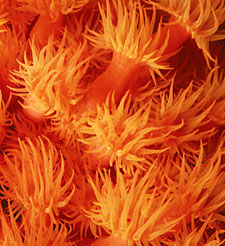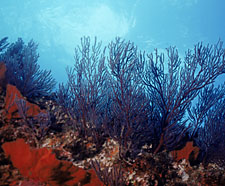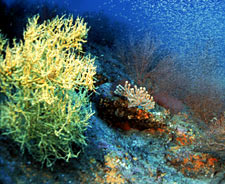![[Ocean Oasis Field Guide]](images/bnr-oo-field.gif)

![[Ocean Oasis Field Guide]](images/bnr-oo-field.gif) |  |
|
Hydrozoa, Scyphozoa, Anthozoa
Phylum Cnidaria "stinging-cells" (jellyfish, anemones and corals) | |
DescriptionMost corals are colonies of many individual animals that share a common skeleton. Each individual is called a polyp. The body of the polyp occupies little cups or corallites attached at the bottom and joined in a common skeleton of the colony. The stony corals secrete external skeletons made of calcium carbonate (limestone). Corals may be colonial or solitary. Each polyp has a series of tentacles around the mouth. Each tentacle is equipped with several stinging capsules, the nematocysts. This stinging apparatus is characteristic of the phylum Cnidaria. The animal discharges harpoon-like stingers coiled inside a fluid-filled capsule to capture zooplankton. Range and HabitatReef-building corals are only found in the tropics, although other types of corals are found throughout the world's oceans. Reef-building corals have organisms called zooxanthellae present in their tissues. Zooxanthellae are unicellular algae which live symbiotically within the corals and provide nutrients so that the corals can produce the large reefs typical of tropical seas. Natural HistoryThe thin layer of epidermis that secretes the calcium carbonate covers the skeleton. Therefore, technically, it can be considered an "internal skeleton." However, because the coral colony in true stony corals sits atop a large, non-living calcareous framework, most authors speak of this skeleton as being "external." These skeletons give the polyps a certain degree of protection from nipping and grazing predators. But the coral polyps still get eaten by butterflyfish, and parrotfish use their strong, beak-like fused teeth to grind up bits of coral tissue. The polyps may be of different colors, such as white, purple, orange, yellow, etc. At first sight when diving a coral reef, it looks like a garden. However, corals are not plants. Corals are colonies of thousand of tiny creatures that build upon another, all reaching out into the currents for food. Reproduction: Corals have both sexual and asexual reproduction. Highsmith (1982), has reported fragmentation as a means of starting new colonies in some species. However, the time at which corals form gametes depends upon the size and age of the parent colony. Therefore, fragmentation or partial destruction can affect the fecundity of the colony. Corals can be broadcast spawners, releasing eggs and sperm into the water (with the time of spawning regulated by lunar events), or brooders, retaining fertilized eggs until they develop into larvae. The planulae larvae swim for a few days before settling down and secreting their own calcium carbonate (limestone) cups to begin a new colony. See the Birch Aquarium website for a video of the coral spawning. |



Top to bottom: Bright yellow cup coral, Tubastraea coccinea, extending polyps to feed, © Bob Cranston |
Text by Patricia Beller
Field Guide |
Site Index |
Ocean Oasis Introduction
|
|
© 2000 San Diego Natural History Museum |